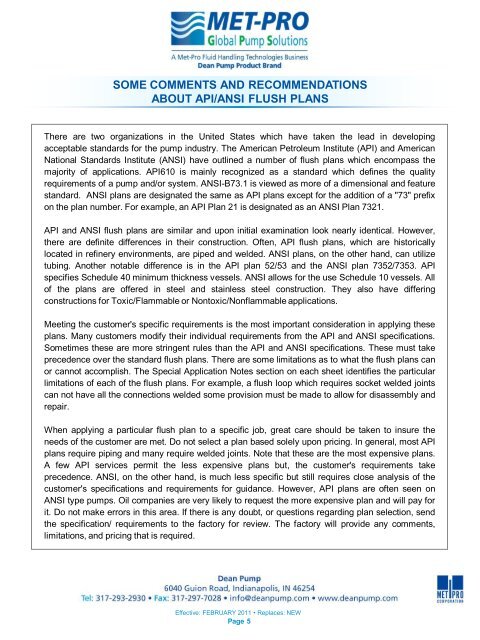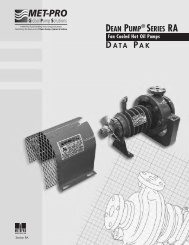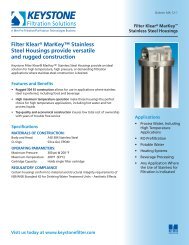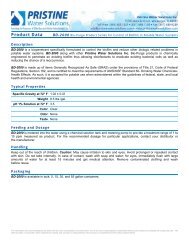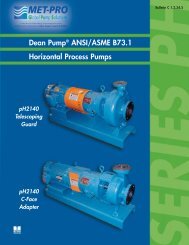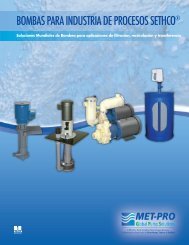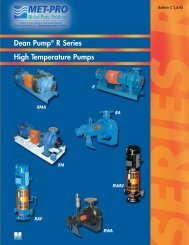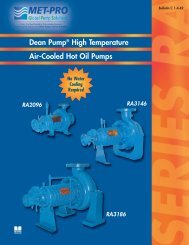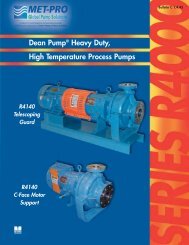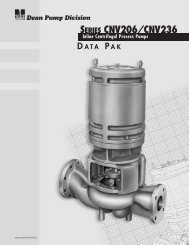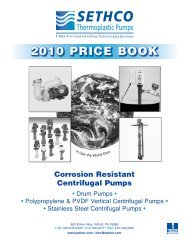flush plans for mechanical seals - Pristine Water Solutions Inc.
flush plans for mechanical seals - Pristine Water Solutions Inc.
flush plans for mechanical seals - Pristine Water Solutions Inc.
- No tags were found...
You also want an ePaper? Increase the reach of your titles
YUMPU automatically turns print PDFs into web optimized ePapers that Google loves.
SOME COMMENTS AND RECOMMENDATIONSABOUT API/ANSI FLUSH PLANSThere are two organizations in the United States which have taken the lead in developingacceptable standards <strong>for</strong> the pump industry. The American Petroleum Institute (API) and AmericanNational Standards Institute (ANSI) have outlined a number of <strong>flush</strong> <strong>plans</strong> which encompass themajority of applications. API610 is mainly recognized as a standard which defines the qualityrequirements of a pump and/or system. ANSI-B73.1 is viewed as more of a dimensional and featurestandard. ANSI <strong>plans</strong> are designated the same as API <strong>plans</strong> except <strong>for</strong> the addition of a "73" prefixon the plan number. For example, an API Plan 21 is designated as an ANSI Plan 7321.API and ANSI <strong>flush</strong> <strong>plans</strong> are similar and upon initial examination look nearly identical. However,there are definite differences in their construction. Often, API <strong>flush</strong> <strong>plans</strong>, which are historicallylocated in refinery environments, are piped and welded. ANSI <strong>plans</strong>, on the other hand, can utilizetubing. Another notable difference is in the API plan 52/53 and the ANSI plan 7352/7353. APIspecifies Schedule 40 minimum thickness vessels. ANSI allows <strong>for</strong> the use Schedule 10 vessels. Allof the <strong>plans</strong> are offered in steel and stainless steel construction. They also have differingconstructions <strong>for</strong> Toxic/Flammable or Nontoxic/Nonflammable applications.Meeting the customer's specific requirements is the most important consideration in applying these<strong>plans</strong>. Many customers modify their individual requirements from the API and ANSI specifications.Sometimes these are more stringent rules than the API and ANSI specifications. These must takeprecedence over the standard <strong>flush</strong> <strong>plans</strong>. There are some limitations as to what the <strong>flush</strong> <strong>plans</strong> canor cannot accomplish. The Special Application Notes section on each sheet identifies the particularlimitations of each of the <strong>flush</strong> <strong>plans</strong>. For example, a <strong>flush</strong> loop which requires socket welded jointscan not have all the connections welded some provision must be made to allow <strong>for</strong> disassembly andrepair.When applying a particular <strong>flush</strong> plan to a specific job, great care should be taken to insure theneeds of the customer are met. Do not select a plan based solely upon pricing. In general, most API<strong>plans</strong> require piping and many require welded joints. Note that these are the most expensive <strong>plans</strong>.A few API services permit the less expensive <strong>plans</strong> but, the customer's requirements takeprecedence. ANSI, on the other hand, is much less specific but still requires close analysis of thecustomer's specifications and requirements <strong>for</strong> guidance. However, API <strong>plans</strong> are often seen onANSI type pumps. Oil companies are very likely to request the more expensive plan and will pay <strong>for</strong>it. Do not make errors in this area. If there is any doubt, or questions regarding plan selection, sendthe specification/ requirements to the factory <strong>for</strong> review. The factory will provide any comments,limitations, and pricing that is required.Effective: FEBRUARY 2011 • Replaces: NEWPage 5


